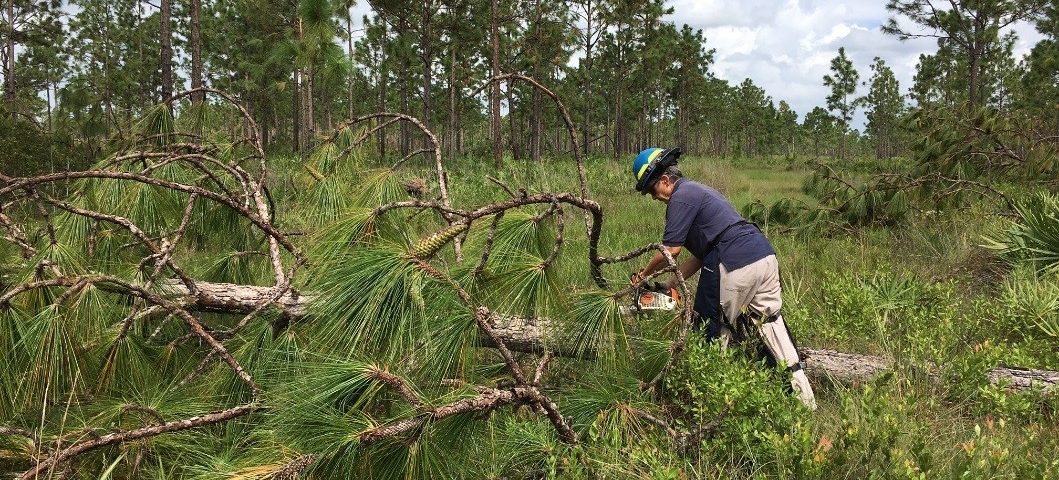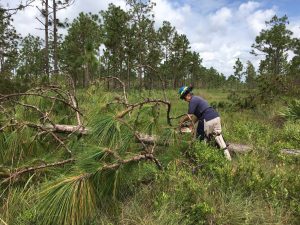District operational update, Sept. 4, 2019

Staff will begin assessing District lands Thursday to reopen to the public as quickly as possible.
Visit www.sjrwmd.com/storm/
PALATKA, Fla., Sept. 4, 2019 — Here is a summary of the St. Johns River Water Management District’s current status of operations:
- The District’s headquarters in Palatka, service centers in Palm Bay, Maitland and Jacksonville and all field stations will reopen at 8 a.m. Thursday, Sept. 5.
- The District will move forward with the scheduled joint workshop and teleconference at 10 a.m., Sept. 5, with Southwest and South Florida water management districts on each agency’s draft 2019 minimum flows and levels and water reservations priority lists and schedules. Interested participants may attend the meeting at the South Florida Water Management District’s St. Cloud Field Station, 3800 Old Canoe Creek Road, St. Cloud, or join by teleconference:
- Phone Numbers: (855) 682-6800 (Toll Free Nationwide)
- (561) 682-6800 (WPB Local Number)
- Access Code: 990 133 420
- All District lands, including the Lake Apopka Wildlife Drive, remain closed until staff evaluate them for public safety. Land managers will begin assessments Thursday morning. For reopening updates, visit the District’s website at www.sjrwmd.com/lands/recreation/announcements/.
- District emergency operations team members and other staff are working around the clock, monitoring water levels and adjusting water control structures as needed, preparing to participate in state search and rescue operations, staging equipment and personnel for recovery efforts and sharing vital information to the public.
- The District’s pump strike team is standing by to offer recovery assistance to flooded communities.
- In the Upper St. Johns River Basin and the Upper Ocklawaha River Basin, water storage is available. The District continues to make minor adjustments to those systems.
- Staff made a gate adjustment at S-96C today to match inflows from Blue Cypress Creek in the Upper St. Johns River Basin Project.
- The Upper St. Johns River Basin Project reduces flooding in much of the upper St. Johns, however, it does not reduce flooding in the river’s middle basin in east-central Florida, including lakes Monroe and Harney, nor further downstream in the river’s lower basin in north Florida.
- The District adjusted the gates at Burrell Dam on Sept. 3 to reduce flow into Lake Griffin from lakes Harris, Eustis, Dora, Beauclair and Little Lake Harris, in the Upper Ocklawaha River system.
- Water began discharging through the Harris Bayou Spillway on Aug. 29. The District has been making small adjustments for several days, along with a corresponding adjustment at the Moss Bluff Dam to pass through increased inflows.
- Locks, spillways, pump stations, levees and canals in the headwaters of the St. Johns River in Brevard and Indian River counties and in the Harris Chain of Lakes in Lake County are the District’s only structural controls of water levels. All these water control structures are in very good shape operationally.
- District staff approved the removal of excavators working on the Flagler County Wetland Restoration Project from the construction areas on Aug. 28 due to flooding concerns. The equipment has been removed and secured by the contractor.
- The District’s webpage at www.sjrwmd.com/storm/ offers information about the storm and water levels, including links to flood statements and warnings, river stage and flooding data, and local government emergency contacts. Also included are links to the National Weather Service, Florida Division of Emergency Management and the U.S. Geological Survey’s interactive map of current conditions in the state.
- Local governments are the primary entities responsible for emergency responses during storms, such as implementing state-of-emergency declarations, evacuations and rescue efforts during flood-related disasters. Homeowners can be prepared for heavy rains by keeping debris out of storm drains and ditches; reporting clogged ditches to local governments; and cleaning out gutters and extending downspouts at least four feet from structures.


